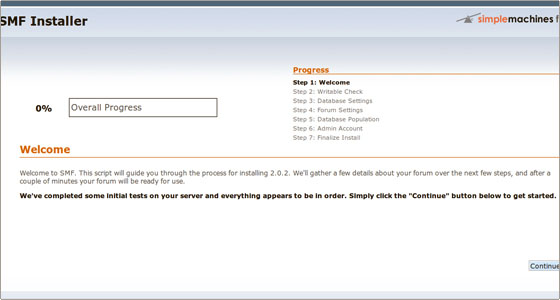
In this tutorial, we will show you how to install the Simple Machines Forum on Ubuntu 14.04. For those of you who didn’t know, Simple Machines Forum (SMF) is a free, professional-grade software package that allows you to set up your own online community within minutes. It is open-source software that is written in PHP and uses a MySQL/MariaDB database. It provides many features and it is user-friendly.
This article assumes you have at least basic knowledge of Linux, know how to use the shell, and most importantly, you host your site on your own VPS. The installation is quite simple. I will show you the step-by-step installation Simple Machines Forum on Ubuntu 14.04.
Prerequisites
- A server running one of the following operating systems: Ubuntu 14.04, and any other Debian-based distribution.
- It’s recommended that you use a fresh OS install to prevent any potential issues.
- SSH access to the server (or just open Terminal if you’re on a desktop).
- A
non-root sudo useror access to theroot user. We recommend acting as anon-root sudo user, however, as you can harm your system if you’re not careful when acting as the root.
Install Simple Machines Forum on Ubuntu 14.04
Step 1. First of all, make sure that all packages are up to date.
apt-get update -y
Step 2. Install LAMP (Linux, Apache, MySQL, PHP) server and include some PHP extensions.
apt-get -y install apache2 mysql-server mysql-client php5 php5-mysql php5-gd sendmail
Start Apache and MySQL services:
/etc/init.d/apache2 start /etc/init.d/mysql start
Step 3. Configuring MySQL.
By default, MySQL is not hardened. You can secure MySQL using the mysql_secure_installation script. you should read and below each step carefully which will set a root password, remove anonymous users, disallow remote root login, and remove the test database and access to secure MySQL.
mysql_secure_installation
Create a new MySQL database for Simple Machines on your server:
## mysql -u root -p CREATE DATABASE smf; CREATE USER 'smf_user'@'localhost' IDENTIFIED BY 'Your_Paasword'; GRANT ALL PRIVILEGES ON `smf`.* TO 'smf_user'@'localhost'; FLUSH PRIVILEGES;
Step 4. Install the Simple Machines Forum on the Ubuntu system.
Now we download the latest version of the SMF installer on your server:
cd /var/www wget https://download.simplemachines.org/index.php?thanks;filename=smf_2-0-19_install.tar.gz tar xvfz smf_2-0-19_install.tar.gz rm -rf smf_2-0-19_install.tar.gz
Grant the right permissions for the folders and files:
chown www-data:www-data /var/www/* -R
Step 5. Accessing the Simple Machines Forum.
SMF will be available on HTTP port 80 by default. Open your favorite browser and navigate to http://your-domain.com or http://your-server-ip. You should see the SMF installer:

When you are finished with the installation you should remove install.php from the SMF directory due to security:
rm -rf /var/www/install.php
Congratulations! You have successfully installed the SMF. Thanks for using this tutorial for installing Simple Machines Forum on Ubuntu 14.04 system. For additional help or useful information, we recommend you check the official SMF website.